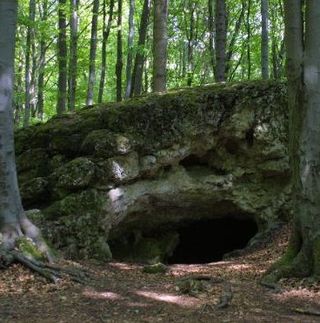Maiden cave
| Maiden cave
|
||
|---|---|---|
|
Entrance to the maiden cave |
||
| Location: | Franconian Switzerland , Germany | |
|
Geographic location: |
49 ° 55 '12 " N , 11 ° 5' 17" E | |
|
|
||
| Cadastral number: | C 238 | |
| Type: | Karst cave | |
| Discovery: | 1951 | |
| Overall length: | 7 meters | |
The Jungfernhöhle is a natural karst cave near Tiefenellern, a district of the Upper Franconian municipality of Litzendorf in the Bamberg district in Bavaria .
The cave was, among other things, a Neolithic cult site of the band ceramists and is located in the Hofbauernholz between the villages of Tiefenellern , Herzogenreuth and Laibarös in the Bamberg district not far from the western edge of the northern Franconian Jura . It is open to the west.
The Jungfernhöhle is shown in the Franconian Alb cave register (HFA) as C 238 and by the Bavarian State Office for the Environment as geotope 471H001. See also the list of geotopes in the Bamberg district .
discovery
The cave was discovered in 1951 by the treasure hunter Georg Engert.
description
The cave is nine meters wide, three meters high and seven meters long. It is a very small cave with a portal only three and a half meters wide and one and a quarter meters high and a shaft leading down steeply. The only room is irregularly shaped with a few small side columns. Excavations have shown the use of the cave by four Neolithic and almost all subsequent cultures. The name Jungfernhöhle comes from the fact that the remains of mostly female people were found during excavations. The name is based on a local legend. According to this, three maidens who lived in the cave are said to have been killed there.
Excavations
In the years from 1951 to 1954 Otto Kunkel , museum director in Stettin until 1945, carried out extensive excavations in the forest area for the Bavarian State Office for Monument Preservation and found:
- Ribbon ceramic vessels as well as bone sticks interpreted as chopsticks from the Neolithic Age .
- Skeletal and skull remains of at least 40 people, 10 to 11 adults (including 9 mostly younger women), 4 to 5 adolescents and 23 infants and children. A radiocarbon dating yielded an age of 6150 +/- 65 years.
Skeleton finds
Most of the riddles were the skeleton finds of the band pottery . Most of the female skeletons (at least 29 were children under the age of 14) were all incomplete. It is believed that it was not a burial site as the skeletons were scattered around. All skulls were shattered and some long bones splintered, suggesting that the bone marrow had been removed. There were no teeth in the jaws. In the meantime, Jörg Orschiedt has been able to prove through detailed investigations that less cannibalism than a special ritual of the dead is to be assumed (see also Herxheim ). No signs of cuts or fire could be detected on the bones. The absence of the front teeth was caused by natural processes.
The cave was used as a sacrificial pit in the Middle and Early Neolithic, in the Bronze , Hallstatt and Latène Ages and still in the Middle Ages.
Transmission
Particularly significant is the fact that there were local legends about haunted headless virgins in the area of the cave before the human remains were discovered in 1958. From this it can be deduced that the knowledge of the sacrificial ritual was passed on orally for about 6150 years.
Surroundings
- Today's memorial cross stood in its place as a field cross , called "Black Cross", long before the discovery of the Jungfern Cave. The rededication of this field cross into a memorial cross for the victims of the Jungfernhöhle did not take place until the 1980s.
- About 120 meters west of the cave, a rocky terrain spur measuring approximately 120 × 80 meters is secured by a surrounding stone wall of unknown date (ring wall in Hofbauernholz). In the east, the area narrows towards the plateau to about 25 meters. A section fortification that was certainly there previously was built over in the Middle Ages. The prehistoric origins of the complex are documented by some early Latène Age fragments and a dagger blade from the Early Bronze Age. The weir system is about 100 meters above the valley and is protected by steep slopes in the north, west and south.
literature
- Otto Kunkel : The Jungfernhöhle near Tiefenellern. A Neolithic cult site on the Franconian Jura near Bamberg . Beck, Munich 1955, ( Munich contributions to prehistory and early history 5).
- Björn-Uwe Abels : Guide to archaeological monuments in Bavaria , Franconia Volume 2: Archaeological Guide Upper Franconia. Konrad Theiss Verlag, Stuttgart 1986, ISBN 3-8062-0373-3 , p. 160.
- Christian Züchner: Tiefenellern, Jungfernhöhle . In: Rainer Hofmann (edit.): Guide to archaeological monuments in Germany, Volume 20: Franconian Switzerland . Konrad Theiss Verlag, Stuttgart 1990, ISBN 3-8062-0586-8 , pp. 196-197.
- Jörg Orschiedt: The Jungfern Cave near Tiefenellern. A reinterpretation . In: 133rd Report of the Historisches Verein Bamberg 1997, pp. 185–198.
See also
Web links
- Landscape Museum
- Obermaing story
- Bavarian State Office f. Environment (LfU): Geotop - Jungfernhöhle near Tiefenellern
Individual evidence
- ↑ Geotope: Jungfernhöhle near Tiefenellern (accessed on August 29, 2013; PDF; 169 kB)
- ↑ Andreas Tillmann: The Jungfernhöhle In: Summer, C. Sebastian (Ed.): Archeology in Bavaria - Window to the Past . Pustet, Regensburg 2006, ISBN 3-7917-2002-3 , p. 62
- ^ Friedrich Herrmann: Caves of the Franconian and Hersbrucker Switzerland. Pustet, Regensburg 1980.
- ↑ Rudolf Reiser: The Celts in Bavaria . Rosenheimer, Rosenheim 1984.


